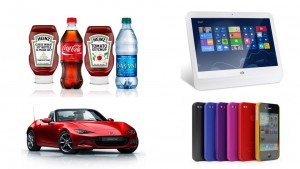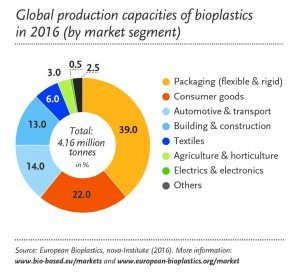Introduction
The motivational driver to the innovation of bioplastics technology was to tackle our addiction to the disposable-everything habit. The disposable-everything eased our lives, but took a huge toll on our environment which lead to the development of biodegradable/compostable disposables to ease off the problems created by us to the environment. In 2010, disposable bioplastics contributed to more than 60% of the total bioplastic production capacity. However, six years down the lane, the durable bioplastics contributes to an enormous 77% of the overall bioplastic production capacity which is estimated to grow above 80% by 2020. This post looks at the importance of bioplastics in the durable plastic sector and the key aspects on its fundamental business cases & drivers.
What are durable bioplastics?
Bioplastics can be broadly broken down into two categories: durable and biodegradable.
- Biodegradable bioplastics break down naturally in the environment or may be composted. This is unique, as the vast majority of plastics today will never break down.
- On the other hand, the PlantBottle is a durable bioplastic alternative to traditional PET bottles made by Coca-Cola. Made with up to 30 percent ethanol sourced from plant material, the PlantBottle won’t decompose, but it can be recycled with traditional PET containers and bottles.
While 100% bio-based and biodegradable plastics are mainly used to substitute the plastics that might end up as litter (usually shopping bags, food packaging, disposables), partially bio-based plastics such as polythene manufactured from sugar cane, can provide a near-perfect substitute for oil-based equivalents in products where durability and robustness is vital. Let’s have a quick look at the various types, feedstock, raw material and applications of major durable bioplastics available in the current market.
Types, Feedstock, Raw Material and Applications of Durable Bioplastics
| Durable Biopolymer | Feedstock | Raw material | Processing | Applications |
| Bio-based Polyethylene terephthalate (PET) | Sugarcane | Sugar | Fermented and distilled to ethanolMonoethylene glycol (MEG) from bio-ethanolMEG is combined with purified terephthalic acid (PTA) | Bottles, containers. |
| Bio-based Polyethylene (PE) | Sugarcane | Sugar | Fermented and distilled to ethanolDehydrated to ethylenePolymerisation | Carry bags, films and bottles |
| Bio-polycarbonate (PC) | Corn | Isosorbide (A monomer that replaces bisphenol A in conventional polycarbonate) | Hydrogenation of glucose to produce sorbitolIsosorbide is obtained from double dehydration of sorbitol | A close substitute for high-performance glass components, electronic equipment, automotive housings, interior and exterior decor |
| Bio-Polyamide (PA 4,10/ PA 6,10) | Castor Oil | Sebacic acid | The dicarboxylic acid (sebacic acid) part of polyamide is produced from renewable resource (castor oil) | Electronics, Automotive, Sports |
| Bio-based polyurethane (PUR) | Corn, Sugar cane, Tapioca | Bio-succinic acid | The adipic acid used to produce conventional PUR is replaced with succinic acid from renewable resources. | Speciality foams, coatings, adhesives, TPU |
Prominent producers of durable bioplastics
| Durable Biopolymer | Producers |
| Bio-PET | Plant bottle by Coca Cola, Toray Industries, Teijin Limited, M&G Chemicals, Toyota Tsusho, Plastipak |
| Bio-PE | Braskem |
| Bio-PC | Mitsubishi, Teijin |
| Bio- PUR | Lubrizol, BASF SE, Bayer Material Science, The Dow Chemical Company, Biobased Technologies and Mitsui Chemicals |
| PA 11 | Arkema |
Business case, Advantages and the key challenges associated with durable bioplastics
Business case
Durable bioplastics are the fastest growing bio-plastic group and the industry interest is based around these two main selling points
- The renewable (or partly renewable) basis of these products reduces their carbon footprint.
- They feature the same properties and functionality as their petrochemical counterparts, meaning they can be processed, used and recycled in existing facilities and following the same routes as conventional plastics. This reduces the need for new or additional infrastructure and reduces costs across all levels.
Advantage over oil-based plastics
| The greatest advantage durable bioplastics have over the biodegradable bioplastics is that – “why create something that requires a significant amount of energy to manufacture, only to have it disappear forever into the soil?” |
When a bioplastic product is composted, the biopolymer can no longer be reused, meaning all of the energy and material is lost in the soil. (Composting makes sense only in certain cases where large volumes of organic landfills are utilized for methane generation and it is not an optimal waste reduction strategy when compared to reuse and recycle). Durable bioplastics that are partly/completely made from plant materials provides us with an opportunity that is more viable to mitigate our dependence on petrochemical plastics. Also, they can still be recycled so those valuable energy and material inputs can be kept in the production cycle longer.
Net Zero by Narsi
Insights and interactions on climate action by Narasimhan Santhanam, Director - EAI
View full playlistKey challenges for durable bioplastics
- Realistically offsetting our dependence on petrochemical plastics by durable bioplastics first requires decreasing the overall demand for plastics. (Currently, Bioplastics represent about one per cent of the about 300 million tonnes of plastic produced annually)
- If the demand is not reduced, there will be a significant increase in the demand for the feedstock such as corn and sugarcane for bioplastic production creating havoc in food production across the world.
Market growth trends in durable bioplastics
Durable bioplastics are the main drivers of the growth of bioplastics industry, with Polyurethane (PUR) making up around 40 percent and PET over 20 percent of the global bioplastics production capacities. More than 75 percent of the bioplastics production capacity worldwide in 2016 was bio-based, durable plastics. In 2010, the share of durable bioplastic in the global production capacity was only around 40% of the total share of 0.7m metric tonnes of bioplastics.
| Year | Total capacity (million tonnes) | Durable (%) |
| 2010 | 0.7 | 40 |
| 2013 | 1.58 | 62.4 |
| 2014 | 1.697 | 60.9 |
| 2015 | 3.952 | 75 |
| 2016 | 4.16 | 76.8 |
| 2020 (Estimated) | 5.95 | 79 |
Inferences on growth potential for durable bioplastics for the short, medium and long term?
There exists a business climate where ‘sustainable’ is not just a buzz word but a political and economic goal. This is leading many plastic producers, traders and most importantly end-users to head away from fossil fuel-based polymers to an age of bio-plastics. Evidence of this sea change can be seen in the actions of world’s leading companies. We have a plastic obsession and it is not going to disappear anytime sooner and the use of finite and fossil resources is only going to increase as time progresses. So, we expect the solution to this obsession lies in the use of bioplastics in applications where it can be recycled and reprocessed continuously which is not the case with biodegradable and short lived applications Published market reviews on bioplastics industry expect growth rates ranging from 15 to 35 percent till 2020 (short-medium term) with production capacity of 6.7 million tonnes by 2018, in which the top performers are expected to be bio-PUR and bio-PET (Durable), followed by PLA (Biodegradable/Compostable). This reflects the industry’s readiness to accept a biopolymer resin that is competitive, technically and economically, and that already have established recycling streams. In the long term, we expect the growth trend to be the same, only for an increased contribution from compostable polymers with the key driving factors to be the scale of production bringing down the overall cost of the biopolymer and improved properties. So what about the biodegradable/compostable counterparts? While PLA is compostable, the cost of the resin, poor-average performance when pitted against its conventional counterpart and low number of industrial composting facilities are currently reducing its appeal. However, given the enormous R&D in the biodegradable polymers, the scale of production of these polymers will help in bringing down the overall cost of the biopolymer and improved technical performance. Bio-plastics will no longer be seen as a way to save the planet with the use of compostable products, but as a natural step in the development of an industry looking at a more sustainable future for the production of plastics. This growth trend of durable applications might be the antidote to oil-based plastics. References and Useful Links
- Industrial Applications of Renewable Plastics
- Why Durable Bioplastics, Not Biodegradable, May Be the Answer
- Applications for Bioplastics
- Bioplastics Magazine
Also check out: EAI Consulting for Bio-energy & Biofuels, Bioplastics & Other Biomass-based Value Added Products






 Our specialty focus areas include
Our specialty focus areas include


 ZEV India Partnership – Driving Truck Electrification through Collaboration
ZEV India Partnership – Driving Truck Electrification through Collaboration

